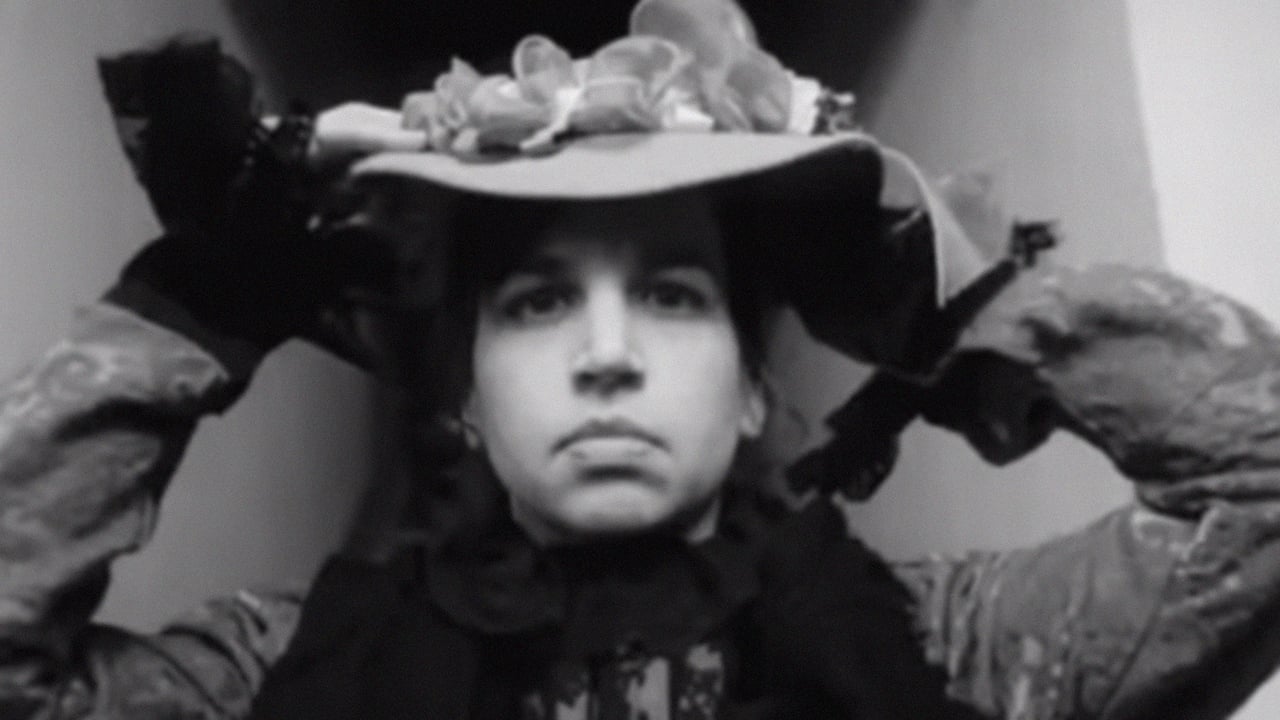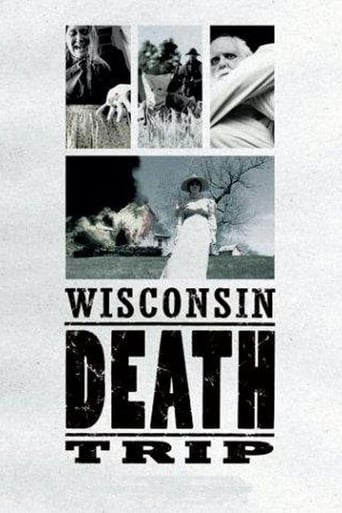

Not in the traditional documentary format, Wisconsin Death Trip is disturbingly beautiful. The first thing that is noticeable about the film is its intensely visual direction in an extremely eye pleasing black and white art house style backed up with Ian Holm's competent narration (another narrator is used in confusing whisper to tell of those sectioned at the mental asylum, something of which doesn't really make any sense of have any meaning to it but is a nice difference in direction). As a documentary, the film just documents facts. Focusing on strange stories from a small Wisconsin town (Black River City) in the 1890's when (unexplainably) the people started to randomly commit crime after crime in horrific fashion through anarchy, murder, arson, paedophilia and other deranged acts (including a humorous tale of a cocaine addict who persistently smashed local windows for now reason.) Wisconsin Death Trip has these moments of humour, but by no way stretch of the imagination is it a pleasing narrative. Harrowing accounts of acts of violence from the local journalist about the occupiers of the small city and its surroundings are reinacted for the screen in a dry, depressing surrealism. In narrating article after article of random stories of suicide, murder etc the Direction shows actors play out these events in a wonderfully designed time of old in America taking us throughout the seasons of the year in subtly effective montages of newspaper being printed. Contrasted to this is a modern perception of the same town, displaying school children in a playground happily getting on with life. The elderly living contently at a home and other accounts and recollections of stories they had heard from rumour about the history of Black River City and Wisconsin. However, the film never tries to even start to understand what happened in that area for everyone to commit these heinous crimes in the 1890's, nor does it seem to hold this as a relevant part tot the story, it merely documents the events that took place with linear narration and hand in hand visual aids that were very cinematic. It differs greatly to traditional documentaries in this sense by not following any one particular story, but deciding to document what had already happened and disturbingly, this film was made for television, something of which is interesting to contemplate how it was marketed. The film may be looked upon as having no real meaning and would bore audiences who seek an answer, but they would be a hard audience not to be drawn into the film by its wonderful cinematography and appealing narrative.
... View MoreI found this documentary to be pointless and useless. The only part I enjoyed about this film was the "flashbacks" to current times in Black River Falls, WI because it is my hometown. Even though the film is about WI's history and Black River Falls, I found it to be boring and uninformative. Watching the film made me feel as if I were insane because I am from BRF. The historical viewpoint was interesting, but it seemed as if the film was saying that WI breeds insanity. I think living in a place with a very small population and little to do would drive me crazy as well. I couldn't find much of a point in the film either.
... View MoreI saw WDT when it was first screened by the BBC, but had been looking forward to it ever since it arrived on the festival circuit. Word of mouth suggested it was dark, unusual and innovative - and, for once, word of mouth was right.Rarely have I seen stronger evidence that truth is indeed stranger than fiction. The stories here are fascinating - twisted tales of everyday folk who would happily fit into any Stephen King novel.And the style of the film is just as remarkable. Beautiful monochrome cinematography and a deadpan voice-over from Ian Holm reflect the macabre lunacy of Black River Falls. Mesmerising and unforgettable.
... View MoreIt is easy to be dazzled by 'Wisconsin Death Trip''s shimmering beauty. It is unlikely that you will see a more beautiful film all year - the sharp monochrome which creates an eerie dream out of history; the breathtaking fluidity of the camera, including some stunning, Angelopolous-like sequence shots; the extraordinary compositions that at once mummifies the subjects, traps them in their time like the still photographs the film is based on, and allows them to burst shockingly free from it. For its brief running time, there is not one ugly or inept sequence, and many in which you will gasp 'wow'. This was made for TELEVISION?! Needless to say, there is nothing like it in the cinema right now.But is all this gorgeousness appropriate to the subject matter, the life and times of a small Wisconsin town, Black River Falls, in the 1890s, only 40 years old, deeply religious, composed of different races, with no troubles from the Indians, that in one decade seemed to burst into a frenzy of febrile anarchy, spewing out random murders, diseases, economic depressions, suicides, infanticides, paedophiliac marriages, persistant window-breakers, faded opera singers and, especially lunatics.The film comprises a series of articles written by the town's English newspaper editor, divided into the four seasons. The stories are an unrelenting catalogue of collective insanity and horror, a complete breakdown of social order - the only time a sheriff is mentioned he is leading a posse hunting a young boy. Interspersed with the sensationalism are reports of the odd attempts at civic propriety, temprance meetings, church warnings against promiscuity etc., but these attempts at social control are tainted by the surrounding madness, and sound as beserk in their optimism as Canute or Quixote.This is quiet American town life as Surrealist nightmare, a real-life David Lynch, a topsy-turvy inversion of what we expect from such communities. It's not like this is some kind of metaphor for what was going underneath repressive propriety - THIS REALLY HAPPENED. Why? There are a number of tacit answers - the economic failure of the American dream resulting in psychological despair (the first case of insanity is an unemployed suicide); the failure of the American melting-pot ideal, the different nationalities divided, unable to assimilate into Americans, their social rupture displaced into psychic rupture; the end of the frontier myth, the idea that there are no more Western open spaces to conquer, a feeling of being hemmed in, confined, hence, perhaps all the lunatic asylum inmates; the supernatural, God, nature - many townsfolk hear voices, fear witchcraft, and there are many shots of nature, piercing sunlight disrupting the calm, speeding, shadowy clouds, that seem pathologised.The problem with the film is its ahistoricism. The events, like the town itself, exist in a vacuum, an aberration. Every story seems connected with some kind of tragedy or fear, but surely the editor's paper was not filled with this stuff all the time on every page; people would surely notice something was seriously wrong. The inexorable horrors become so profuse, so excessive, that they become comic, not because it is too much to bear, but because it seems so implausible. The filmmakers seem to think so too, and the stylised recreations take on a comic element. The film is least successful when it attempts to connect the events of the 1890s with our own fin de siecle - modern day Black River Falls, with its mad old ladies singing Star Spangled Banner, can only seem insane contiguous with its ancestors' dementia, and, in case we miss the point, the slow tracks give an ominous, oneiric feel. As with today, 1890s children with guns go on killing sprees; there are problems with drugs, authority, aimless youth, dysfunctional families etc. The madness never ends.The stories, filtered through the consistent sensibility of the editor, are told in terse, literal, seemingly objective language. But the editor is both male and English-Protestant - he can't help informing his plain words with ideology. His reaction to aberrant women, for example, is typical of the times. They are not conscious rebels against a repressive society, they are invariably hysterical and mad. What is remarkable, though, is how the madness transcends gender, class, age, ethnic boundaries, producing a monstrous parody of the melting-pot ideal, a nation connected by insanity. In this catalogue of death and disease, the one life-force is ironically a window-breaker, a highly educated former teacher who is possessed by the urge to smash every window she comes across. This may be destructive, but she is both an image of freedom and a pattern asserted on the randomness; life in a landscape of corpses.The film raises interesting questions about the documentary form, questions about the truth (the newspaper is a 'journal of record'), about history. The film's structure is based literally on documents, which are read out; there are interviews with real people - surely it's a documentary? But the content is largely a series of recreated scenes - these scenes are not recorded as they happen, which might be a definition of a documentary. Yet 'the Thin Blue Line', winner of the best documentary Oscar, was full of recreations. But, if we call this a documentary, than so is, say, 'The Diary of Anne Frank', starring Shelley Winters. These questions are important - documentary sets itself up on a higher ethical register with some glorified access to truth - we must not let this assumption go unquestioned.
... View More